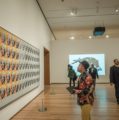
Recent neurological testing has demonstrated that our brains interpret danceable rhythms in specific ways.
In the study, researchers led by Michael Thaut at the Center for Biomedical Research in Music at Colorado State University found that pattern, meter, and tempo processing tasks are managed by the “right, or bilateral, areas of frontal, cingulate, parietal, prefrontal, temporal and cerebellar cortices,” while interpreting tempo alone “engaged mechanisms subserving somatosensory and premotor information.”
In plain English, this means that a tune with an obvious “groove” actually pulls the trigger on our motor system. At the same time, our cerebellum is contributing to the coordination, precision, and timing required to dance. Blood is even directed toward our legs, which gets our toes tapping. Coordinated movements please our brain’s reward centers, so coupling that with a heavy beat is like a double whammy on the brain — and thus creates a desire to dance that’s pretty hard to deny.














